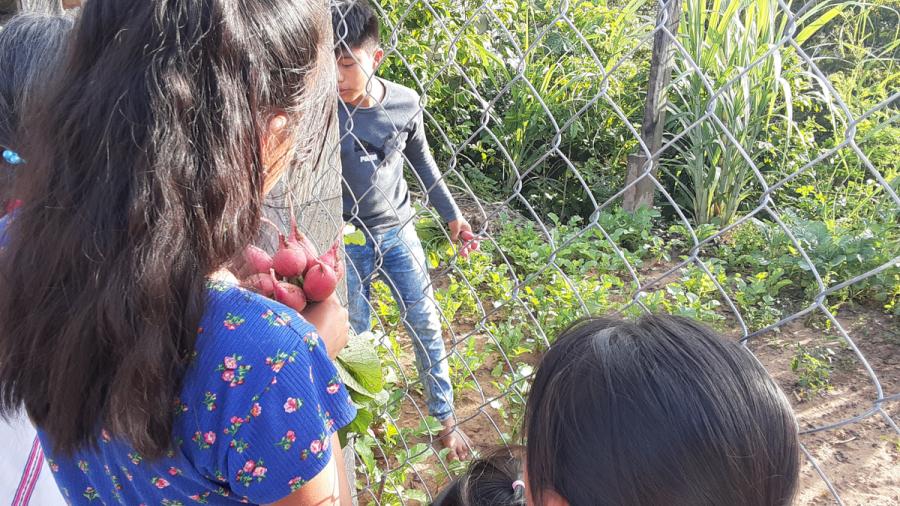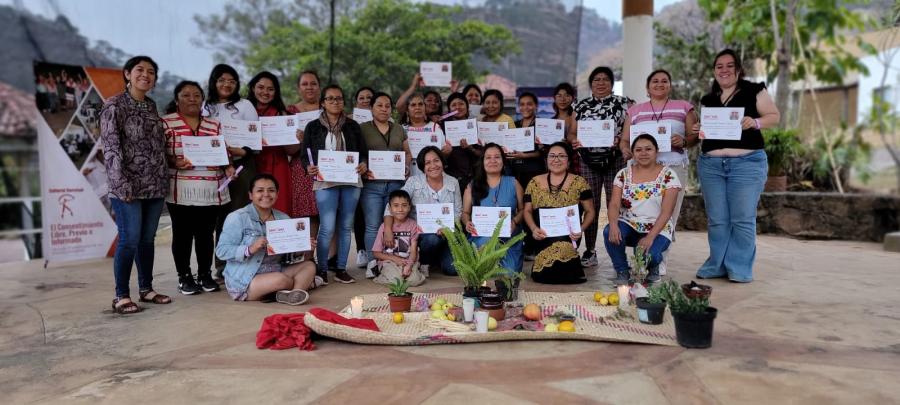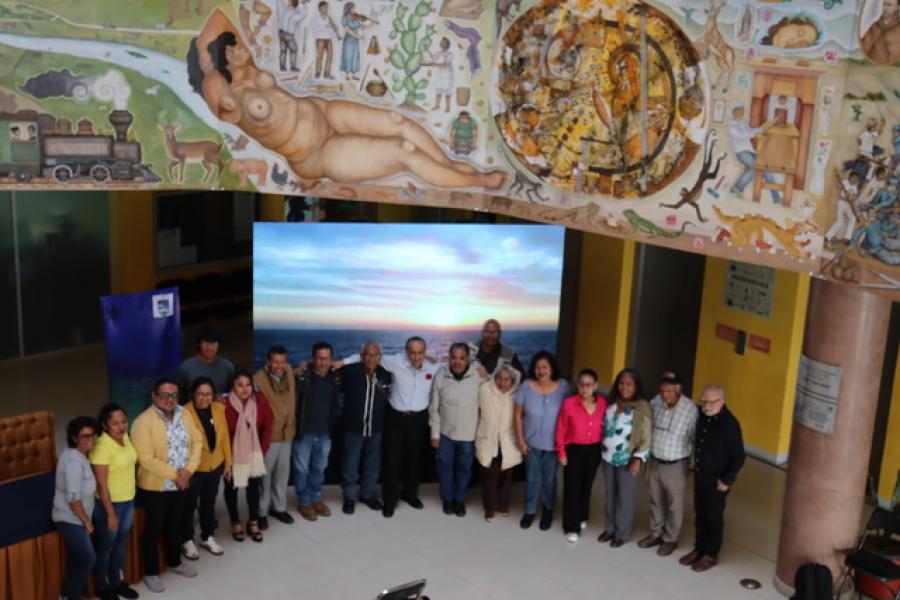The Wixaritari are an extremely religious people, linked through their ancestors to a mythical, primordial past. Despite having adopted some Christian elements, they maintain a mesoamerican religion strongly rooted in their history and surroundings. The current population forms part of a community that has existed for at least 1000 years.(1)
For the Huicholes, the land is the fundamental point of reference for everything from the religious to the productive and the political. In recent times, the land has become the axis around which a territorial organization has been created, which has made it possible to confront external forces that stand in the way of their continued existence as a distinct culture. The Huichol zone extends over 4500 square kilometers, with as much as 80,000 hectares of land invaded by outsiders.
Their forms of organization, shaped over the years, create the basic equilibrium of the Huichol community, fundamentally a clan society whose highest leader is the wisest elder, called Kawitero (one who knows the way). The Kawiteros and the Ma'arakate (clan leaders) are charged with naming, though dreams and consensus, those who are to hold office in the community. The community offices are divided into two groupings:
a) Religious affairs, in which traditional authorities are selected annually.
b) Agrarian affairs, in which offices last three years and are carried out by the Communal Lands Commission.
Land tenancy is communal and, by custom, all Wixaritari children have the right to be joint owners, as long as they meet the inherent obligations. Their family ties bind them strongly to their clans.
Despite the fact that the inhabitants of the western sierra have ancestral needs, decades of dispossessions, and cultural weakening as a result of the breakup of their territories, a total absence of basic services and subsistence agriculture that does not support their families, the challenges to the Huicholes' survival have worsened in recent years.
The current economic situation and growing needs have forced them to enter the labor market as day-workers, thus becoming an important labor reserve for Zacatecas agribusiness and Nayarit tobacco growers. In addition to exploiting their labor, these industries are causing illnesses from direct exposure to pesticides.
Despite all of this, the defense and preservation of their habitat has become the overriding necessity, and a powerful incentive to community organizing. In 1989, the four Wixaritari pueblos decided to organize themselves regionally through their Union of Indigenous Huichol Communities (UCIH) and requested support from our organization to bring their territorial problems before the courts. Since that time, the Huichol communities have experienced a strong wave of organizing, which has led to their recovery, through the agrarian courts, of 10,320 hectares. All the cases brought by the Huicholes have been successful, including their complaint before the International Labor Organization (the first case world-wide to deal with the recovery of indigenous land).
The Huichol people's land struggle is becoming more complex, making it necessary for the efforts in defense of their habitat to generate organizing efforts that allow them to take ownership of their situation as a people; in other words, this struggle has brought them to the search for autonomy as a broad frame of reference. At the same time, they have acquired a growing command of their own rights, as the young people have become effective bearers of the elders' principles' of struggle.
Their refusal to cede the enormous areas whose titles are held by others demonstrates the importance this territory has for them, and also shows the strength of their social relations. Based on family clans belonging to the various ceremonial centers, which in turn are part of the networks of the sacred, these relations are meeting the charge of caring for the life of the world. According to the Huicholes, their ancestors placed the candles which invoked rain for the entire planet.
The Huichol people's land struggle has become an important case in Mexico because it converges with the aspirations of other Indian peoples that are questioning the State and society at large over three important issues: democracy, sovereignty and territorial rights. The solution to these issues implies the respect and recognition of:
a) The exercise of multiple collective rights that have been systematically denied.
b) A territoriality in accordance with the bases of the country's identity.
This people's efforts have become part of a struggle that is "framed by the international recovery of identities; efforts that form part of the mosaic of struggles for diversity which open up the possibility of generating another societal project, with a distinct democratic culture, in which all would converge based on who they are and hope to be."(2)
The geographic location of the Huichol region is a clear indicator of the source of their agrarian and political problems; although the central part of the community is located in Jalisco, important segments are in the adjacent states of Zacatecas, Durango and Nayarit.
This location was the principal reason why the communities' titles were confined within the Jalisco state borders, which dispossessed them of significant portions of their territories, those titles were then granted to neighboring Mestizo groups by the federal government. The title-holders have pushed the Huicholes to the limits of injustice, preventing them from planting, keeping animals and following their traditions. Nevertheless, the Huicholes have not abandoned all of their holdings, rather, they continue to occupy strategic points within the territory and are now demanding the reunification of these lands based on their historical and cultural rights.
For the first time, the Wixaritari are brining their demands before the national courts and the International Labor Organization. Their demands are based on very strong principles that justify their right to recover large areas due to their ethnic identity and their rights based on ancestral possession. Through the application of a legal strategy that combines juridical, historical, topographical, and anthropological arguments, they have been able to legally recover 10,320 hectares, with 67,000 still in dispute.(3)
Different factors have come together in this process, but the most important is that the community elders' territorial consciousness has been effectively passed on to the young people. Together, they have built a defense strategy that joins with other indigenous peoples, who also are defending their right to consolidate a vital space in which to exercise their decision-making power over their own issues, and which involves the ongoing deployment of their rich historical and cultural resources. In this way, organizational processes are emerging in the Sierra that parallel and complement the land struggle which will surely force the recognition of the Wixarika region, in spite of the municipal and state boundaries which have historically attempted to divide it.
The fact that legal claims are being won, and the organization-building involved, has transformed the aspirations for territorial titles into the need for real appropriation and control of all that occurs in the community. For this reason, the process of territorial recovery is giving rise to a broader search for autonomy which results not only in the Huicholes' new language, but also in new relationships with the federal and state authorities and more solid relations with their sister pueblos.
Without a doubt, the movement generated in Mexican society since the EZLN uprising has had a profound impact in Wixarika sierra, as the Huicholes see the Zapatistas as a strong moral and political point of reference, encouraging them to continually reflect on their own path as an Indian people who longs for political and cultural control over their space.
The Huichol people are experiencing a turning point. In response to their gamble on the legal strategy and the advances generated through judicial processes that settle the ownership of their territories, some authorities have openly declared that the courts' decisions will not be respected. Nevertheless, to have won 153 rulings against invading ranchers and their case before the ILO has allowed them to glimpses new horizons. Their actions also contribute very directly to the process of democratic transition that we are going through, as the resolution of their demands is related to the full exercise of all of our rights. Their struggle to build a new country is ours as well.
Today the efforts towards an inclusive society that respects the identities of peoples are part of a process that requires the convergence of social sectors, those who understand the need to rethink the paradigms of civilizations in order to guarantee human and social sustainability in the long term. "The world's indigenous population, calculated at 300 million, lives in areas that have 60 percent of the planet's natural resources. For this reason, the many conflicts regarding the use and destiny of their lands involving the interests of governments and businesses are not surprising...The exploitation of natural resources (petroleum and mineral) and tourism are the principal industries which threaten indigenous territories in the Americas."(4)
As a result, the struggle for peoples' identity is in reality a struggle over the riches of the planet and for the possibility of considering approaches that differ from the dominant one, and is becoming a major political issue.
Notes:
1) AJAGI, Liffman, Vazquez and Macias "Peritaje antropológico histórico, zona occidental de San Andrés Cohamiata, Municipio de Mezquitic, Jalisco. Participación ceremonial y tenencia de la tierra en la cultura wixarika, "unpublished document, Pag. 1.
2) Canabal Cristiani, Beatriz, Xochimilco: una identidad recreada, Mexico City: UAM-X, 1997.
3) It is relevant that each community has gone about preparing their own cases with an understanding of the necessary legal steps and the rights that support them. For example, Wuat? a (San Sebastián) has brought 139 cases against the invaders of Puente de Camotlán, and one that has been legally concluded and won against the Barranca del Tule ejido. Tuapurie (Santa Catarina) definitively defeated the Minjares family and is still fighting against the invading Nuñez family. Tateikie (San Andrés) won the conflict over the boundaries of the Refugio ejido through the courts, and is pressing for the invalidation of the maps of neighboring San Juan Peyotán. They have also brought an injunction against the Colegiado de Mazatlán, Sinaloa, which could lead to the recovery of an area important to the Tierra Blanca zone.
4) Martha Garcia in La Jornada, May 28, 1997.
Article copyright Cultural Survival, Inc.



